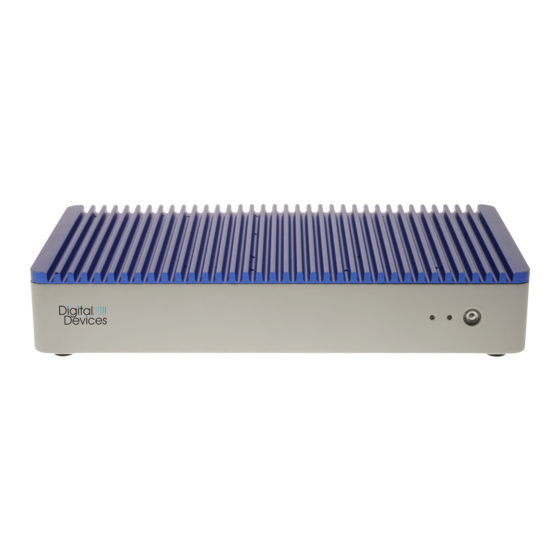
Table of Contents
Advertisement
Quick Links
Advertisement
Table of Contents

Summarization of Contents
Safety Instructions
General Information
Provides general guidance for safe operation and longevity of the Octopus NET SL-MC.
Operational Safety
Details safety precautions for connecting and operating the Octopus NET SL-MC, including who should perform the connection.
Installation Site
Specifies safe installation locations and conditions, emphasizing protection from electrical hazards and environmental factors.
Electromagnetic Compatibility
Outlines guidelines for electromagnetic compatibility (EMC) and minimum distances from interference sources.
Cleaning
Provides instructions for cleaning the Octopus NET SL-MC, emphasizing the need to disconnect power.
General Information
Receive Modules
Details the specifications and capabilities of different receive modules available for the Octopus NET SL-MC.
Octopus NET SL-MC-S (DVB-S/S2)
Specifies features for the DVB-S/S2 satellite tuner version, including protection and support.
Octopus NET SL-MC (DVB-S/DVB-S2/ISDB-S or DVB-C/C2/ISDB-C/J.83 or DVB-T/T2/ISDB-T)
Details the multi-band tuner capabilities for satellite, cable, and terrestrial reception.
Miscellaneous
Lists miscellaneous features such as the on/off switch, power supply, temperature range, and dimensions.
Description
Front View
Illustrates and labels the components visible on the front panel of the Octopus NET SL-MC.
Back View
Illustrates and labels the connectors and controls on the rear panel of the device.
Octopus NET SL-MC
First Start
Provides initial steps for starting the Octopus NET SL-MC, including unpacking and checking components.
Connection
Guides the user on how to physically connect the Octopus NET SL-MC to the network and power.
Configuration
Explains how to configure the Octopus NET SL-MC, including network name and IP address access.
The Web Interface
Overview
Provides a general overview of the web interface, including navigation links and system status.
Overview - Tuner
Details information about the available tuners, their status, and signal strength.
Overview - System Information - Update
Explains how to update the system firmware via the web interface.
Overview - System Information - Changing the Date / Time
Guides on how to manually set or automatically synchronize the device's date and time.
Overview - System Information - Change Password
Details the process for changing the default administrator password for security.
Overview - System Information - Factory Reset
Explains how to reset the Octopus NET SL-MC to its factory default settings.
Overview - System Information - Reboot
Describes how to restart the Octopus NET SL-MC through the web interface.
Overview - System Information - Delete Transmitter Database
Explains how to delete the saved station list and configured streams.
Network Configuration
Network - General
Details general network settings like hostname, nameserver, and UPnP.
Network - Set Static IP
Provides instructions for configuring a static IP address for the device.
Channel Scanning
Channel Scan - DiSEqC (MC-S only)
Details the DiSEqC settings for channel scanning on specific models.
Station Search - Scan Your Own Transponder List
Guides on scanning channels using a custom transponder list in .ini format.
Channel Search - Manual Transponder Scan
Explains how to perform a manual scan by entering frequency, symbol rate, and polarity.
Multicast
Multicast - Export or Import List
Allows saving and loading multicast configurations for easier setup.
Multicast - Remove All Streams
Provides functionality to delete all configured multicast streams.
Multicast - Tuner Settings
Directs users to the tuner settings related to multicast.
Multicast - Basic Information
Explains supported protocols (UDP/RTP) and IP address generation for multicast streams.
Multicast - Advanced Settings
Details advanced settings for multicast streams, including IP, port, protocol, and EPG data.
Unicast
Unicast - Exporting or Importing the List
Allows saving and loading unicast configurations for faster setup.
Tuner Settings
Tuner - Operating Mode (MC-S Only)
Explains how to set the operating mode for satellite tuners (Direct 4, Quad LNB, Unicable).
Tuner - Unicable Settings (MC-S Only)
Details specific settings for Unicable configuration, including frequency and slot.
Common Interface (CI)
Common Interface - CAM Options
Details CAM options, including module restart, channel assignment, and accessing CAM menu.
Setup Examples Clients
Configuring Multicast Configuration for Panasonic TV
Guides on creating and uploading M3U lists for multicast streaming to Panasonic TVs.
Structure of the M3U List for Panasonic TV (Simple)
Explains the simple format of M3U playlists for Panasonic TVs.
Structure of the M3U List for Panasonic TV (Enhanced)
Details the enhanced format of M3U playlists with extended parameters for Panasonic TVs.
Configuration on the Panasonic TV
Provides step-by-step instructions for configuring a Panasonic TV to receive multicast streams.
Configuring Multicast Configuration for MAG250 STB
Guides on creating and loading M3U lists for multicast streaming to MAG250 STBs.
Structure of the M3U list for MAG250 STB
Explains the M3U playlist structure for MAG250 STB.
Configuration on a MAG250 STB
Provides steps for configuring a MAG250 STB to receive multicast streams via USB.
Software Tool / Client
Recommends VLC Player for testing M3U lists and extending device scope.
Digital Devices
Product Portfolio
Details the range of Digital Devices DVB products, including Cine, DuoFlex, and Octopus series.
Service Information
Provides contact information for service and support inquiries.
Naming Rights
States that rights to software product names belong to their respective licensees.


Need help?
Do you have a question about the Octopus NET SL SX8 and is the answer not in the manual?
Questions and answers